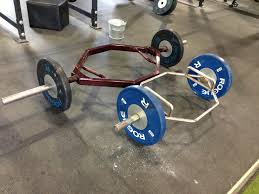
This month I’ll be analysing a recent study entitled Optimal Loading Range for the Development of Peak Power Output in the Hexagonal Barbell Jump Squat, by Turner, Tobin, and Delahunt, published in The Journal of Strength & Conditioning Research (2014). (Check out the picture below to see what a hex bar looks like.)

The Study
The aim of the study was to determine what load would produce the highest power output in the hex bar jump.
The test group was made up of 17 professional rugby union players. Each performed three unloaded vertical jumps and a number of weighted hex bar jumps. The weights used were 10%, 20%, and 30% of the athletes’ Box Squat 1 rep max. Three jumps were performed with each weight.
A Force Plate was used to determine the amount of power produced by each jump. A force plate is just a metal plate, a bit like a bathroom scale, with sensors attached which reads electrical output proportional to the force on the plate (it tells you how much power is produced by a movement such as a jump).
What did they find?
The researchers found that for most of the athletes (14 of the 17) involved in the study the highest amount of power was produced using a load of either 10% or 20% of their Box Squat 1 rep max. In simple terms this means that, based on the results of this study, if you choose to use hex bar jumps to train lower body power you can’t go far wrong with using 10% – 20% of your Box Squat 1 rep max as a suitable load. In my opinion though the most interesting thing to come out of this study was actual the power output readings they recorded when performing loaded hex bar jumps. Here’s why.
Hex Bar Jumps vs Olympic Lifts
Hex bar jumps performed in the manner tested by this study would most likely be used to develop explosive power in the legs with a view to increasing qualities such as sprint speed, rapid change of direction and of course jumping ability.
Traditionally the go to (gym based) tools for developing these attributes would be the Olympic lifts and their derivatives, seen by many coaches as the Gold Standard in power training. Numerous professional sports use these lifts to assess how explosive and powerful an athlete is and countless athletic training programs include the Olympic lifts for this purpose.
The reasoning behind the inclusion of the Olympic Lifts is sound and based largely on the considerable bank of evidence which demonstrates that huge amounts of power are produced when performing them. The problem is that they are highly technical, require a significant investment of time in developing decent technique and can be tough on the wrists, elbows and shoulders.
By contrast the hex bar jump is extremely easy to coach and comparatively easy on the small joints. I have been using hex bar jumps in my programs for a couple years now and have never had an athlete take longer than a few minutes to get to grips with them. Wouldn’t it be great if this simple to teach and learn, relatively safe exercise could compete with the Oly lifts when it came to training explosive power…
Power Outputs
This study recorded a maximum power output of 5,783.40 watts in the hex bar jump. The authors were not the first to have analysed the power outputs in hex bar jumps. In their 2012 paper entitled Effect of Load Positioning on the Kinematics and Kinetics of Weighted Vertical Jumps Paul Swinton (and colleagues) recorded a peak power output of 4,606 Watts when using a load relative to 20% of a Hex Bar Deadlift 1 rep max.
This is great information to have as it allows us to compare these reading with results from comparable studies done on the Olympic lifts so we can see how the humble hex bar jump stacks up!
In 2005 a team of researchers led by Naoki Kawamori published an article entitled Influence of Different Relative Intensities on Power Output During the Hang Power Clean: Identification of the Optimal Load. They recorded a peak power output of 4,281.15 Watts in the Hang Power Clean (one of the most commonly programmed Oly lift variations for athletic development). Both Hex bar jump studies showed greater peak power outputs than this!
What Does this Mean?
If you are an athlete whose sport requires you to run, jump, hit, throw or pedal fast, explosive legs will enable you to do this. In my opinion, the results of this study make a compelling argument in favor of selecting hex bar jumps as a key tool for developing that power. While I have only compared the results of two Hex bar jumps studies with one on the Hang Power Clean I believe there is sufficient evidence to suggest that if your program calls for an Olympic lift you would be perfectly justified in substituting it for the Hex Bar jump, particularly if you don’t already have solid technique in the Olympic lifts. Keeps the reps and sets low and perform them at the start of your session when you are fresh. It is important to note however that the primary study looked at in this article only addresses Peak Power output and while this is important it is not the be all and end all of exercise selection when it comes to developing speed and explosiveness in an athlete.
But I’m No Athlete
While it may seem like an exercise such as the Hex Bar Jump has little relevance to the recreational gym goer don’t underestimate the positive impact adding some explosive training to your program can have. Check out our article on speed work for strength athletes to see how gaining power can help you increase your strength and our whole body training article to see how greater strength can lead to bigger muscles. And if none of that interests you you could still give them a go as they’re more fun than the leg press!
Let us Help You #BeMoreAwesome
If this article has inspired you give Hex Bar Jumps a try contact Will or drop into Plymouth Performance Gym anytime for some advice!

